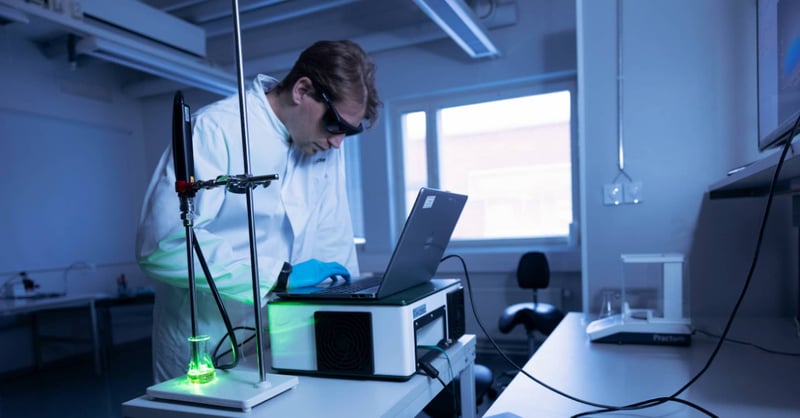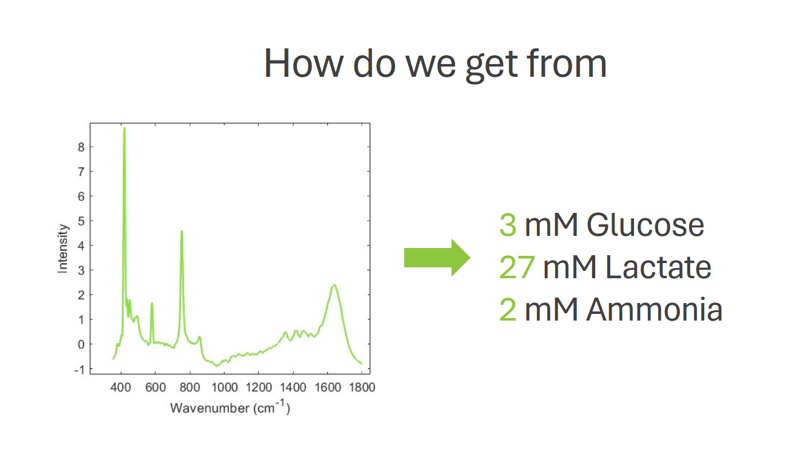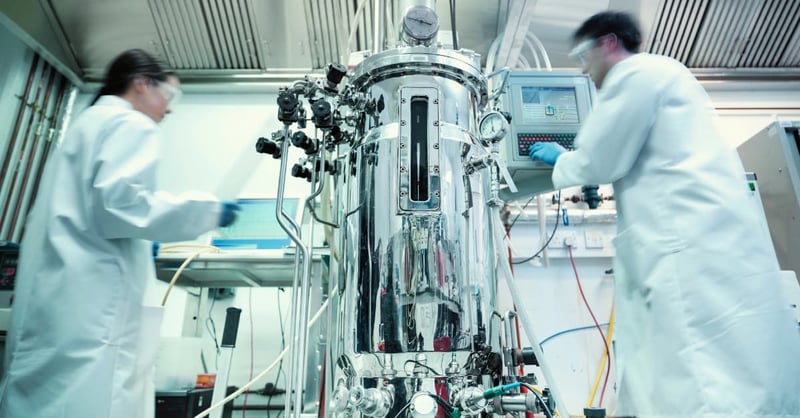Top 8 Benefits of Timegated® Raman in Process Monitoring
For the past 40 years, Raman spectroscopy has been widely used for numerous chemical research applications. Now, the new time-gated Raman technology broadens the application range of Raman to many new fields such as life sciences where for example fluorescence interference has hampered successful Raman analyses earlier.
Online, real-time process monitoring with fast measurements and measurement results offers several benefits to improve operational and manufacturing excellence. With time-gated monitoring tools and services, you can optimize your process constantly. This leads to the 8 benefits of Timegated® Raman in process monitoring.
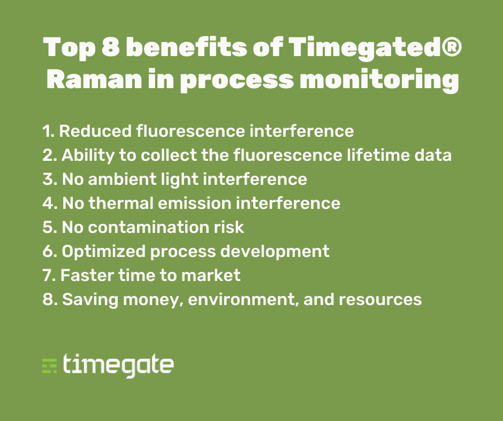
List of top 8 benefits of Timegated® Raman in process monitoring.
Efficient fluorescence suppression and fluorescence lifetime data collection
Conventional Raman spectroscopy has suffered from fluorescence background swamping the Raman signals. Therefore fluorescence emission is seen as the main challenge for achieving detailed Raman analysis data. Timegated® Raman resolves the current limitations by providing time-gated detection for fluorescence suppression, advanced pulsed laser, and in addition the possibility to determine the fluorescence lifetimes simultaneously. The temporal intensity distribution of the fluorescence information provides an additional data dimension to the Raman measurement results.
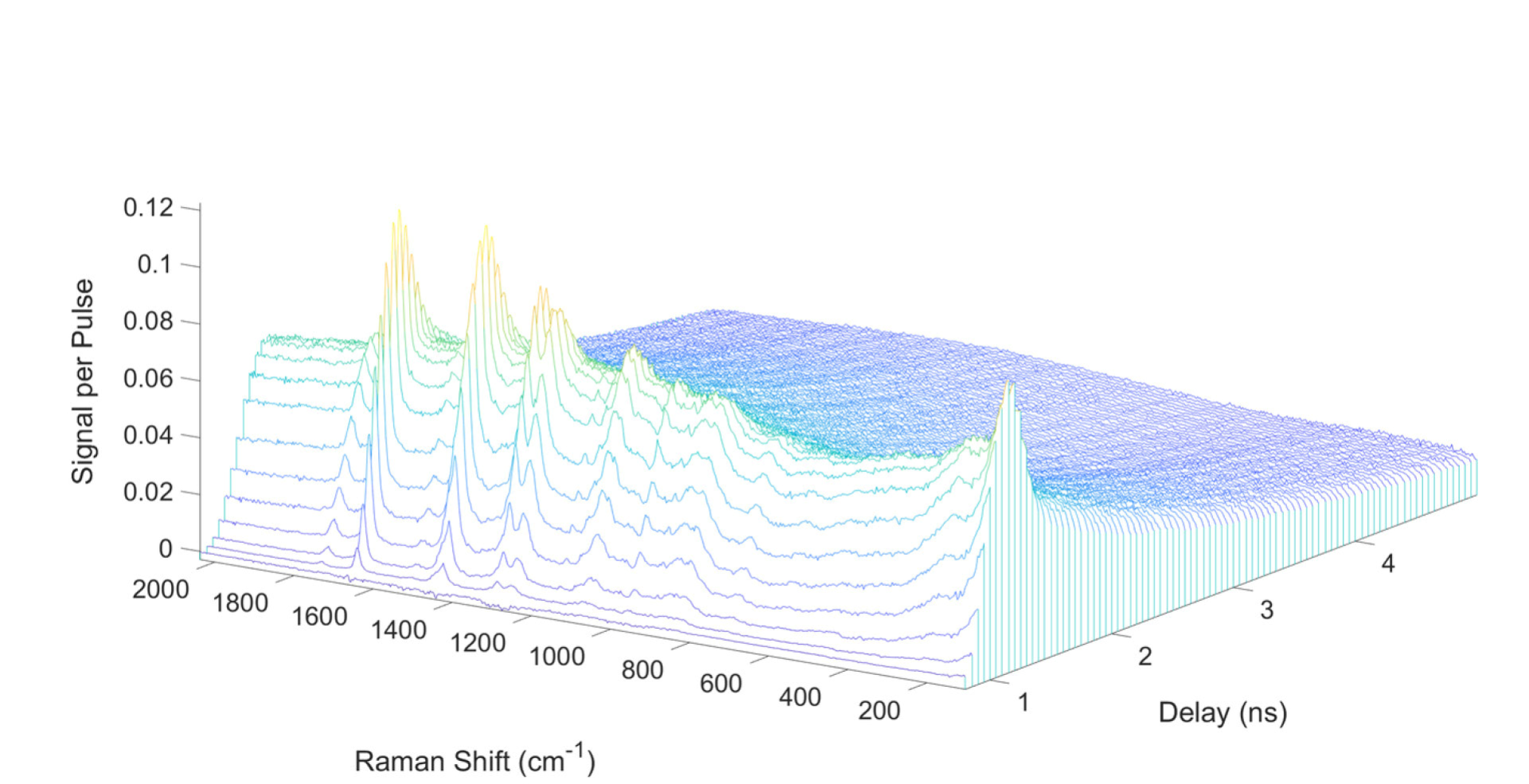
Timegated® Raman 3D spectrum.
Fluorescence suppression is based on only including data from a time range containing a significant amount of Raman information while containing a minimum amount of the interfering background photoluminescence (incl. fluorescence) intensity. Time-gating exploits pulsed lasers which can be used to collect information during moments of time where most of the Raman scattering is located while excluding most of the fluorescence interference. This exclusion is most effectively realized when fluorescence has a long delay compared with Raman scattering i.e. when there is a minimal amount of temporal overlap between Raman scattering and fluorescence emission.
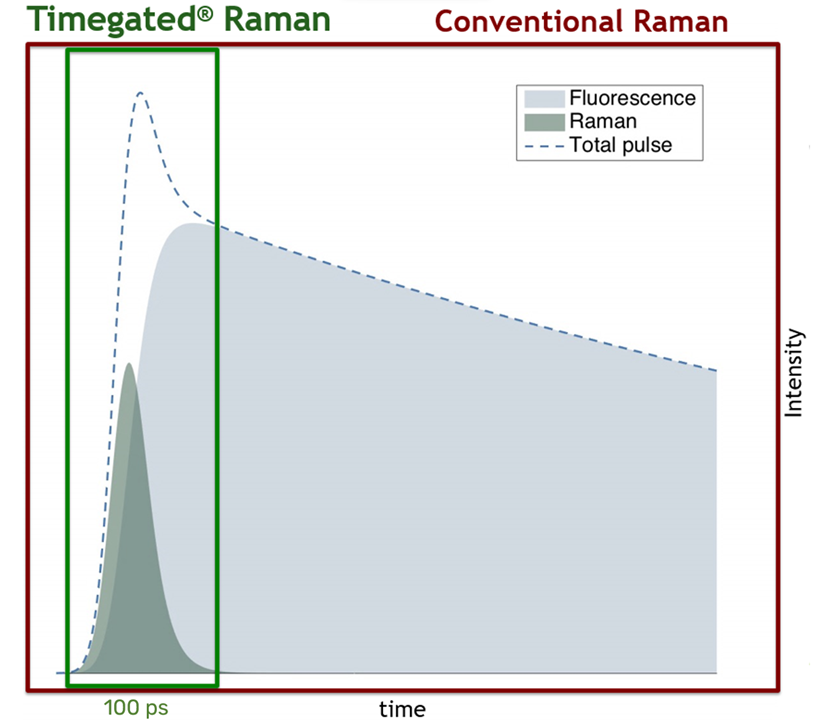
Time-gated fluorescence suppression is based on the temporal exclusion of fluorescence. Time-gating enables capturing Raman signal within 100 picoseconds before fluorescence emergence.
Time-resolved background i.e., fluorescence surface contains fluorescence decay information and no Raman signals. More on fluorescence suppression: Time-gating and other fluorescence suppression techniques.
No ambient light interference
With conventional continuous wave Raman spectroscopy, spectra often contain broad background interference when measuring samples outside sample enclosures in ambient light. This may limit the use of measurement configurations and may force the use of closed sampling systems.
During time-resolved measurements, the detector is only active for extremely short, repeated periods of time. A single photon pulsed laser which is used in time-gated Raman has a very high instantaneous pulse energy and the instantaneous Raman scattering “burst” intensities can be quite high compared with conventional CW Raman scattering. These features lead to a collection of high amounts of Raman scattering in short, repeated time periods i.e., the collected Raman scattering to background emission ratio is high. Because of this, time-resolved Raman is significantly less sensitive to continuous background interference like ambient light or thermal emission.
The spectra measured in three lighting conditions are presented below. As can be observed from the spectra, ambient lighting has a minimal effect on the measurements even when a bright light is pointing directly at the measurement spot.
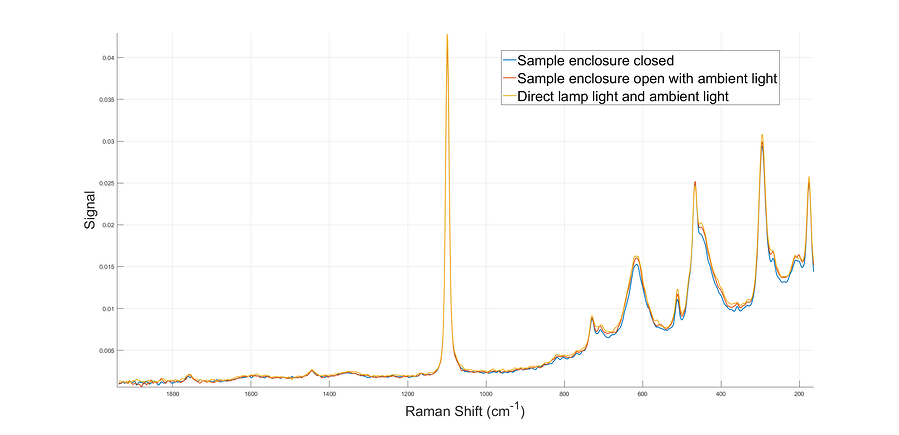 Three spectra measured in different lighting conditions have minimal differences.
Three spectra measured in different lighting conditions have minimal differences.
Time-resolved Raman provides a convenient way to carry out measurements as it is not sensitive to bright or changing lighting conditions. Furthermore, it does not require impermeable covering from ambient light. This enables the use of flexible, open sampling and measurement configurations. More on ambient light suppression: Timegated® Raman Measurements - Effective suppression of ambient light interference.
No thermal emissions interference
Many phase changes and reactions of interest happen in high-temperature conditions. Raman measurements can be used to collect vital information in these extreme conditions, and they can even be simultaneously used for temperature determinations. As Raman is a non-contact technique, measurements can be carried out from a distance reducing the risk of thermal damage to measurement devices.
A significant challenge with high-temperature Raman measurements is interference caused by thermal emission. This interference can easily obscure lower-intensity Raman responses and decrease signal-to-noise ratios in temperatures exceeding 1300 K or even 1800 K.
In high-temperature measurements, the measured intensity is a sum of the Raman signal and thermal emission (fluorescence not discussed here). The aim is to keep the detected Raman scattering to thermal emission ratio as high as possible for optimal results. Pulsed time-resolved techniques aim to do this by using energy-dense laser pulses and by only collecting data during the resulting pulses originating from the sample.
The figure below compares continuous wave and pulsed data acquisition with high-temperature applications. This comparison also applies to other continuous interferences e.g., ambient light.
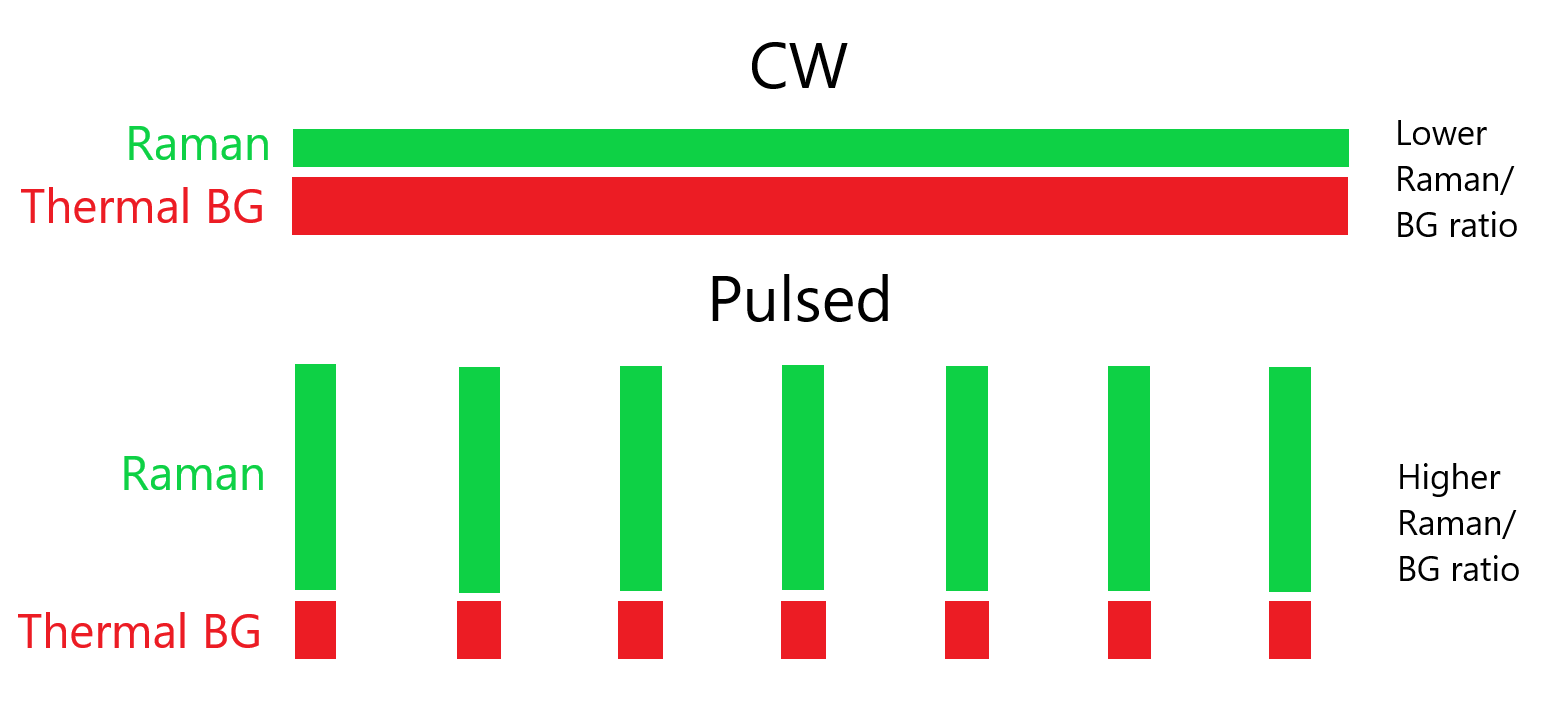 Time-gated pulsed laser´s impact on the thermal background and Raman spectra collected compared to the conventional Raman.
Time-gated pulsed laser´s impact on the thermal background and Raman spectra collected compared to the conventional Raman.
As discussed earlier, whereas continuous wave techniques collect information continuously, pulsed systems only collect data during short pulses. As these pulses have a high peak power and the detector is not collecting information between pulses, the resulting Raman to thermal background ratio is high. An additional benefit of pulsed time-resolved techniques is that the thermal background can be measured right before a pulse. More on thermal emission interference: High Temperature Raman measurement techniques.
No contamination risk with Timegated® Raman
Time-gated Raman technology has the useful properties of being a non-destructive and non-contact analysis technique. There is no contamination risk and no volume perturbation because there is no need for manual sampling and offline lab analyses. Also, TG-Raman measurements require minimal or no sample pre-treatment. These points lead to a reduced number of process failures. Also, the product quality is improved via controlled processing.
Faster time to market through optimized process development
Timegated® Raman offers several benefits to improve operational and manufacturing excellence constantly. Online, real-time monitoring with a compact and portable instrument leads to faster measurements. Highly specific chemical information and concentration quantification with TG-Raman instruments lead to improved productivity through increased yields. Optimized process development and scale-up enable a faster time to market.
Saving money and the environment
The use of Timegated® Raman spectroscopy saves money, the environment, and resources and therefore supports sustainable development. The operational costs are reduced by optimized process development leading to a reduction in workload. Furthermore, time-gated Raman measurements do not acquire analytical chemicals or consumables. By better monitoring possibilities, environmental impact and carbon footprint are reduced.
Would you like to test how our time-gated Raman technology works for measuring your samples? Order a sample measurement easily by using our website ordering platform!
Timegated® Raman white papers in Life Sciences:
- Biopharmaceuticals - How to increase product yields in biopharmaceutical manufacturing?
- Monitoring cell culture media by Timegated Raman spectroscopy - Time-gated Raman spectroscopy with aqueous cell culture media samples
- Pharmaceutical Analysis - Time-gated Raman Spectroscopy to the drug quality monitoring
- Pharmaceuticals - Why solid state forms are so important in pharmaceutical industry?
- Rapid Milk Analysis - The white paper compares continuous wave Raman spectroscopic technique to time-gated Raman technology on different varieties of milk and milk products

